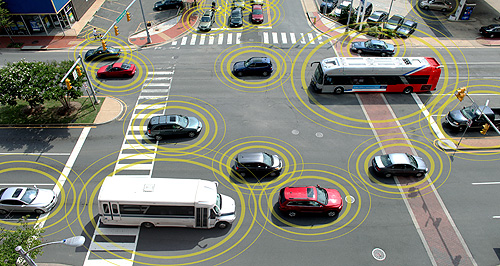Make / Model Search
News - General News - SafetySafety question on vehicle-to-vehicle GPS systemsTalking cars: Vehicles will “talk” to each other to avoid collisions and maintain lanes – if GPS signals are sufficiently accurate. NSW tests show GPS not always accurate enough for new anti-crash technologies18 Sep 2013 GLOBAL positioning system (GPS) signals available in Australia are not always sufficiently accurate to safely support proposed vehicle-to-vehicle and vehicle-to-infrastructure anti-crash and traffic management systems, according to Intelligent Transport Systems (ITS) Australia director Andrew Mehaffey. GPS is at the core of such experimental vehicle wireless communications systems – dubbed V2X – that allow cars, trucks, buses and motorcycles to automatically “talk” with one another to avoid collisions and to link into official traffic control systems to cut the road toll and increase road efficiency globally in the next decade or so. Like other countries, Australia is dependent on American satellites for the GPS service used in car sat-nav systems, aircraft and ship navigation and a multitude other services. Speaking to GoAuto on the eve of the biennial Australian Intelligent Transport Systems Summit in Sydney, Mr Mehaffey said GPS worked well for the most part on ITS road systems tested in Australia, accurately locating vehicles in most situations. However, he said these systems needed to be accurate to a metre or two to allow vehicle road lane determination – an essential part of such intelligent road transport services. Road trials by a New South Wales government Roads and Maritime Services test vehicle had discovered that the necessary accuracy from GPS satellites in Australia was not always available. “In our trials here in Sydney, we have actually found that, to support the level of expectation for ITS, the GPS we have here in Australia still has a few accuracy concerns,” he said. “We can’t get down to the lane level of accuracy. So, there is still a way to go in technology.” Mr Mehaffrey, whose day job is NSW Roads and Maritime Services transport strategy and systems executive manager, said he did not know why GPS available here lacked the apparent accuracy of services in the United States and Europe, where advanced testing of mass fleets of vehicles fitted with V2X systems is already underway. “I am not a GPS expert, but I think they might have a better selection of satellites available to them,” he said. But Mr Mehaffrey said other technological solutions might be found to help overcome the problem. He said Google reportedly was working on land-based navigation signal systems that might fill the gaps where accuracy from GPS satellites was an issue. “Technology always finds a way,” he said. Mr Mehaffrey, who is also chairman of the organising committee for the third biennial ITS Australia Summit in Sydney this week, said that although extensive A2X trials were underway around the world, including in Australia at Wollongong, it still had some way to go before it could be rolled out successfully here. He said that while some vehicle manufacturers would be in a position to introduce A2X by about 2015, such systems probably would not become universal in Australia until about 2025. The Australian government-backed National Transport Commission last year issued a discussion paper seeking industry and public submissions on issues concerning such systems, saying the technology offered potential to significantly reduce Australia’s road trauma while also improving productivity, air quality and carbon emissions. Under A2X, each vehicle is equipped with a GPS-located device that “talks” with other vehicles within about one kilometre, alerting the driver if the vehicles are on a collision course, even if the vehicles are unsighted. Such systems can also be a boon to road traffic managers, helping to warn traffic of road impediments and keep traffic flowing at optimum levels. Mr Mehaffrey said a number of questions remained on the technology, including privacy concerns, possible mandatory introduction and other issues, and these needed to be answered before Australia could move forward with such systems. He said ITS Australia – representing a broad spectrum of transport industry companies, government and motoring organsations – was committed to seeking a national approach to ITS to avoid cross-border issues. “Getting the whole state thing to line up is part of our objective,” he said. This year’s Australia ITS Summit will hear from Australian and overseas experts, including ITS America chairman Peter Sweatman, who is a director of the University of Michigan Transportation Research Institute – a partner in the world’s biggest A2X trial involving more than 3000 vehicles in Ann Arbor, Michigan.  Read more |
Click to shareGeneral News articlesResearch General News Motor industry news |












Facebook Twitter Instagram